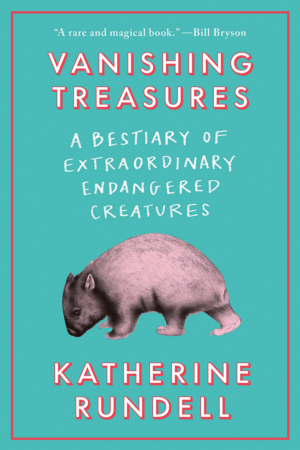Who doesn’t love a good hunt for buried riches?
When you were a child, tales of pirates and gold-filled chests caught your fancy, and every bare spot in the ground had potential. You might have learned, as an adult, to use a metal detector, or you’ve changed your definition of riches. Now you hunt flea markets, thrift stores or, as in the new book “Vanishing Treasures” by Katherine Rundell, you just look outside.
An ostrich awkwardly hides by putting its head in the sand.
You’ve likely heard that myth all your life and by now, you probably know it’s not true. Human history is filled with things that were wrongly believed or misunderstood through the centuries, but if our forebears had only looked, they’d have found greater (and truer!) wonders in the creatures that surround us.
They might have been more careful with our natural resources, too. So many of the world’s creatures are endangered or have almost nearly disappeared.
Take, for instance, the wombat, whose defense mechanism is behind it: his hard-cartilage butt can crush the skull of a predator. Or the Greenland shark, who can live to be six hundred years old or more.
The raccoons that turn over your trash cans are “explorers,” preferring new places to eat and hang out in. Giraffe mothers produce wax on their nipples to keep milk from leaking, and seal mother’s milk is more than ten times fattier than human milk. Lemurs fight by shaking their stinky tails at one another and staring menacingly. Fecund hares can “get pregnant while already pregnant.” Elephants are terrified of bees. Seahorses and golden moles can turn rainbow colors. Other endangered creatures are killed for their body parts but, says Rundell, “the sum total of” authentic, non-medical, animal-based “natural aphrodisiacs… is zero.”
To save them all from total extinction, she says, “The time to fight, with all our ingenuity and tenacity, and love and fury, is now.”
Imagine a world without tuna fish, hermit crabs, or elephants. Imagine no storks or bears. Can’t do it? Then you need to read “Vanishing Treasures.”
Likening our world to a “Noah’s Ark in reverse,” author Katherine Rundell gives readers many good and fascinating reasons to care about these endangered creatures, and her words are urgent but she doesn’t preach. Instead, there’s wry humor in the way she presents facts, and that’ll make you laugh sometimes. The last chapter will give you pause.
You’ll also be amazed at what you’ll learn about both the everyday animals and the creatures you don’t see often — information that’s shared in short, quick-to-read essays that present wide-eyed wonder at the astounding things those animals can do and the adaptations nature has given them. That makes this book an almost awe-inspiring celebration of animal differences, and a love letter to the things you won’t want to see vanish.
Certainly, animal lovers will want to read this book, as will anyone concerned about wildlife, conservancy, or climate change. For anyone ages 15 to adult, “Vanishing Treasures” is good as gold.
“Vanishing Treasures: A Bestiary of Extraordinary Endangered Creatures” by Katherine Rundell
c.2024, Doubleday
$26.00
224 pages




